- Mixtures
- General Properties of Mixtures
- Examples of Mixtures
- Heterogeneous Mixture
- Homogeneous Mixture
- Characteristics of Mixtures
- Pure And Impure Substances
- Characteristics of Pure Substance
- Characteristics of impure Substance
- Melting Point and boiling Point
- Methods of separating mixtures
- Decantation
- Filtration
- Evaporation
- Distillation
- Fractional distillation
- Industrial application of Fractional distillation
- Sublimation/deposition
- Chromatography
- Solvent extraction
- Crystallization
- Using magnets
MIXTURES, ELEMENTS AND COMPOUNDS
A mixture is a combination of two or more pure substances which can be separated by physical means. There are two types of mixtures:
General Properties of Mixtures
Mixtures are made up of two or more substances that are not chemically combined with each other. The properties of mixtures are listed below.
- The components of a mixture each keep their original properties.
- The separation of components can be easily done.
- The proportion of the components is variable.
- Crude oil: A mixture of organic compounds (mainly hydrocarbons)
- Seawater: A mixture of various salt and water.
- Air: a mixture of various gases like oxygen, carbon dioxide, nitrogen, argon, neon, etc.
- Ink: A mixture of coloured dyes.
- Gunpowder: A mixture of sulfur, potassium nitrate and carbon.
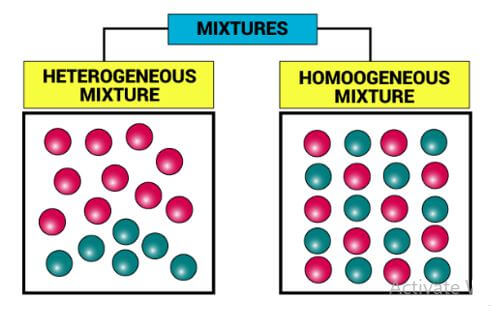
There are two main types of mixtures: homogeneous mixtures and heterogeneous mixtures. The types of mixtures are discussed below.
- Heterogeneous Mixture
What is a Heterogeneous Mixture?
A mixture of sand mixed with salt is an example of a heterogeneous mixture. Heterogeneous mixtures possess different properties and compositions in various parts i.e. the properties are not uniform throughout the mixture.
Examples of Heterogeneous mixtures – air, oil, water, etc. - Homogeneous Mixture
What is a Homogeneous Mixture?
Sugar mixed with water is the most common example of a homogeneous mixture. Homogeneous mixtures can be defined as the mixtures which possess the same properties and combination throughout their mass.
Examples of Homogeneous mixtures – alloys, salt, and water, alcohol in water, Cup of Coffee, Mouthwash, Detergent
The constituents of a mixture are not present in a fixed ratio. The various characteristics of mixtures are discussed below.
- There is no chemical force acting between the two or more substances that are mixed, but they still exist together.
- They can either be heterogeneous or homogeneous in nature.
- The proportions of the substances vary in an indefinite manner.
- The properties of the mixture depend upon the individual components.
- The constituents of the mixture can be separated by physical methods.
- The boiling point and the melting point of the mixture depends upon the characteristic of the constituents.
- During the formation of a mixture, there is no change in energy.
- All the states of matter (solid, liquid, gases) can combine to form mixtures.
It can be concluded that almost everything in our vicinity is nothing but a mixture. For example, the food we eat is a mixture of ingredients, the atmospheric air we breathe is a combination of gases and the locomotives is a heterogeneous mixture.
he fuel we use in W
a substance is said to be pure if it is made up of only one kind of molecule or particle. Pure substances normally cannot be separated by simple physical methods and are largely classified as elements and compounds.
Substances are either pure or impure. A pure substance is one which contains only one substance. An impure substance is one which contains two or more substances. A pure substance is made up of a pure solid, pure liquid or pure gas.
Characteristics of Pure Substance
- They are perfectly homogenous in nature.
- They are made up of only one kind of atoms or molecules.
- They have a fixed composition.
- It has fixed density, melting point and boiling point etc.
Characteristics of Impure Substance
- It does not have any specific properties; the properties of the mixture are a result of the average properties of all the constituents.
- It is formed as a result of a physical change.
- They have a variable composition.
- The mixtures are either heterogeneous or homogenous mixture in nature.
Melting Point and boiling Point
The melting point is usually defined as the point at which materials changes from a solid to a liquid.
The boiling point of a liquid is the temperature at which the vapour pressure of the liquid becomes equal to the atmospheric pressure of the liquid’s environment. At this temperature, the liquid is converted into a vapour.
The boiling point of the liquid depends upon the pressure of the surrounding. When the liquid is at high pressure, it has a higher boiling point than the boiling point at normal atmospheric pressure. The boiling point of different liquids is different for a given pressure
The boiling point for any material is the temperature point at which the material transforms into the gas phase in the liquid phase. This happens at 100 degrees centigrade for water. The Celsius scale was in fact created on the basis of the ice/water melting point and the liquid water/vapor boiling point. Each substance carries its own boiling point.
The boiling point of a substance is dependent on the pressure of its surroundings. In mountainous terrains (where the altitude is high), the pressure of the atmosphere is relatively lower than the atmospheric pressure at sea level. This is the reason why food cooks at a slower pace in mountainous areas (the lower atmospheric pressure causes water to boil at temperatures below 100ºC).
When all the particles in the liquid phase have been transformed into the gas phase, the temperature begins to rise again, as long as heat is still being applied to the surrounding system. As the temperature starts to increase, so does the particle’s kinetic energy.
Boiling Point of Water
Water can boil, raise temperature or decrease air pressure, in two ways. At sea level, it is the pressure of air that causes water to boil at 100oC. Water can boil at a much lower temperature in vacuum, where there’s no air. That is, if not for the skin that keeps the blood pressurized, body temperature would be sufficient to cause the blood to boil with water. At low air pressure the water boils significantly below 100oC at temperatures.
The boiling point of water is the temperature at which the liquid water vapor pressure is equal to the pressure surrounding the body, and the body transforms into a vapour. The boiling point is the temperature for a particular liquid to boil at. For example, the boiling point for water, at a pressure of 1 atm, is 100 degrees Celsius. A liquid’s boiling point depends upon the liquid ‘s temperature, atmospheric pressure, and vapor pressure.
Melting point of ice
For ice, the melting point is 0°C or 273K. The chemical element with the highest melting point is tungsten (3410°C), which is used for making filaments in light bulbs.
During the melting process, till all the ice melts, the temperature of the system does not increase until after the melting point is reached. The whole of the supplied heat energy is consumed in increasing the potential energy of the ice molecules. The kinetic energy of the molecule does not increase further, and the temperature does not increase, so long as the melting continues.
The quantity of heat required to completely change 1 kg of ice into water at atmospheric pressure at its melting point is called latent heat of fusion.
METHODS OF SEPARATING MIXTURES
Mixtures can be separated from applying the following methods:
Sediments can be separated from a liquid by pouring out the liquid. This process is called decantation.
Experiment
Put some sand in a beaker. Add about 200cm3 of water. Allow sand to settle. Pour off water carefully into another beaker.
Observation
Sand settles at the bottom as sediments.
Less clean water is poured out.
Explanation
Sand does not dissolve in water. Sand is denser than water and thus settles at the bottom as sediment. When poured out, the less dense water flows out.
Decantation leaves suspended particles in the liquid after separation. Filtration is thus improved decantation. Filtration is the method of separating insoluble mixtures/particles/solids from a liquid.
Experiment: To separate soil and water using filtration
Fold a filter paper to fit well into a filter funnel. Place the funnel in an empty 250 cm3 beaker.
Put one spatula end full of soil into 50cm3 of water. Stir. Put the soil/water mixture into the filter funnel.
Observations
Clean water is collected below the filter funnel.
Soil remains above the filter paper.
Explanation
A filter paper is porous which act like a fine sieve with very small holes. The holes allow smaller water particles to pass through but do not allow bigger soil particles. The liquid which passes through is called filtrate. The solid which do not pass through is called residue.
Set up of apparatus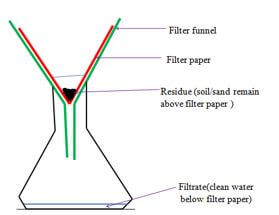
In industries, filtration is used in engine filters to clean up air.
Processes in purification/treatmetn of water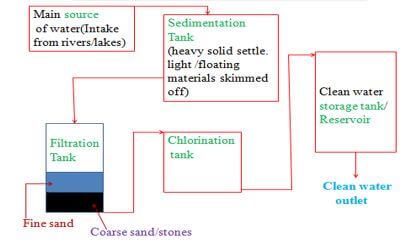
Evaporation is a method of separating a solute/solid from its solution. This involves heating a solution (solvent and solute)to vapourize the solvent out of the solution mixture leaving pure solute/solid. If a mixture contain insoluble solid, they are filtered out.
Experiment: To separate a mixture of soil and salt (sodium chloride).
Procedure:
- Put one spatula end full of soil on a filter paper.
- Put one spatula full of common salt/sodium chloride into the same filter paper. Mix well using the spatula,.
- Place about 200cm3 of water into a beaker.
- Put the contents of the filter paper into the water. Stir thoroughly using a glass/stirring rod for about one minute.
- Fold a filter paper into a filter funnel.
- Pour half portion of the contents in the beaker into the filter funnel.
- Put the filtrate into an evaporating dish. Heat on a water bath.
Observation
- On mixing
Colourless crystals and brown soil particles appear on the filter paper. - On adding water
Common soil dissolves in water. Soil particles do not dissolve in water. - On filtration
Colourless liquid collected as filtrate below the filter funnel/paper.
Brown residue collected above the filter funnel/paper. - On evaporation
Colourless crystals collected after evaporation
Explanation
Solid mixture of sand and common salt take the colors of the two.
On adding water, common salt dissolves to form a solution.
Soil does not because it is insoluble in water and thus forms a suspension.
On filtration, a residue of insoluble soil does not pass through the filter paper.
It is collected as residue.
Common salt solution is collected as filtrate.
On heating the filtrate, the solvent/water evaporate/vaporize out of the evaporating dish leaving common salt crystals.
Vapourization/evaporation can take place even without heating.
This is the principle/process of drying wet clothes on the hanging line.
Set up of apparatus
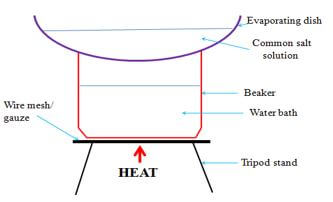
Distillation is an improved evaporation where both the solute and the solvent in the solution are separated /collected. Distillation therefore is the process of separating a solution into constituent solid solute and the solvent. It involves heating the solution to evaporate/vaporize the solvent out. The solvent vapour is then condensed back to a liquid.
Salty sea water can be made pure through simple distillation.
Any mixture with a large difference /40ºC in boiling point can be separated using simple distillation.
Fractional distillation is an improved simple distillation used specifically to separate miscible mixtures with very close /near boiling points.
Fractional distillation involves:
- Heating the mixture in a conical/round bottomed /flat bottomed flask.
The pure substance with a lower boiling point and thus more volatile evaporates/boils/vaporize first.e.g. Pure ethanol has a boiling point of 78ºC.Pure water has a boiling point of 100ºC at sea level/one atmosphere pressure.
When a miscible mixture of ethanol and water is heated, ethanol vaporizes /boils/ evaporates first because it is more volatile. - The conical/round bottomed /flat bottomed flask is connected to a long glass tube called fractionating column.
The purpose of the fractionating column is to offer areas of condensation for the less volatile pure mixture.
The fractionating column is packed with glass beads/broken glass/ porcelain/ shelves to increase the surface area of condensation of the less volatile pure mixture. - When the vapors rise they condense on the glass beads/broken glass /porcelain / shelves which become hot.
When the temperature of the glass beads/broken glass/porcelain/shelves is beyond the boiling point of the less volatile pure substance, the pure substance rise and condensation take place on the glass beads/broken glass/porcelain/shelves at a higher level on the fractionating column.
The less volatile pure substance trickles/drips back down the fractionating column or back into the conical/round bottomed /flat bottomed flask to be heated again. e.g.
If the temperature on glass beads/broken glass/porcelain/shelves is beyond 78ºC, the more volatile pure ethanol rise to condense on the glass beads/broken glass /porcelain/shelves higher in the fractionating column.
Water condenses and then drip/trickle to the glass beads/broken glass /porcelain /shelves lower in the fractionating column because it is less volatile. - The fractionating column is connected to a Liebig condenser. The Liebig condenser has a cold water inlet and outlet circulation.
The more volatile mixture that reach the top of the fractionating column is condenses by the Liebig condenser into a receiver. It is collected as the first fraction. - At the top of the fractionating column, a thermometer is placed to note/monitor the temperature of the boiling mixtures.
Pure substances have constant/fixed boiling point. When one mixture is completely separated, the thermometer reading rises.
E.g. the thermometer reading remains at78ºC when ethanol is being separated. When no more ethanol is being separated, the mercury/alcohol level in the thermometer rises. - The second /subsequent fractions are collected in the receiver after noting a rise the mercury/alcohol level in the thermometer.
E.g. the thermometer reading rises to 100oC when water is being separated. It is passed through the Liebig condenser with the cold water inlet and outlet circulation. It is collected different receiver as the second/subsequent fraction. - Each fraction collected should be confirmed from known physical/chemical properties/characteristic.
Example
Ethanol
Ethanol is a colourless liquid that has a characteristic smell .When it is put in a watch glass then ignited, it catches fire and burn with a blue flame.
Water
Water is a colourless liquid that has no smell/odour .When it is put in a watch glass then ignited, it does not catch fire.
Set up of apparatus
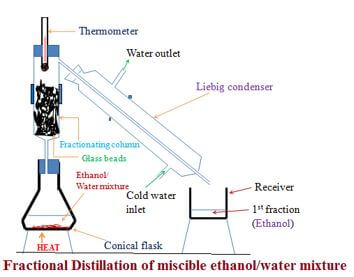
Industrial application of Fractional distillation
On a large scale,fractional distillation is used:
- In fractional distillation of crude oil in an oil refinery.
Crude oil is a mixture of many fractions. When heated in a furnace, the different fractions separate out according to their boiling point. In Kenya,fractional distillation takes place at Changamwe in Mombasa. - In fractional distillation of air.
Air contain a mixture of three main useful gases which are condensed by cooling to very low temperature (-200ºC) to form a liquid. The liquid is then heated. Nitrogen is the most volatile (-196ºC) and thus comes out as the first fraction. Argon (at -186ºC) is the second fraction. Oxygen ( at -183ºC) is the last fraction. The three gases are very useful industrial gases.
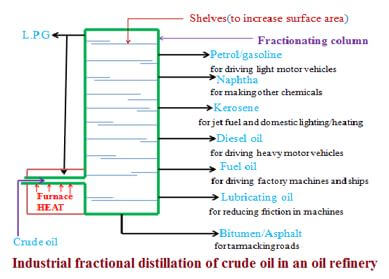
Some solids on heating do not melt to a liquid but change directly to a gas. The process by which a solid changes to a gas is called sublimation. The gas cools back and changes directly to a solid. The process by which a gas changes to a solid is called deposition. Sublimation and deposition therefore are the same but opposite processes.
Some common substances that undergo sublimation/ deposition include:
- Iodine
- Carbon(IV)oxide
- Camphor (iv) ammonium chloride
- Iron(III)chloride
- Aluminum(III)chloride
- benzoic acid
If a mixture has any of the above as a component, then on heating it will change to a gas and be deposited away from the source of heating.
Procedure
- Place about one spatula full of ammonium chloride crystals into a clean dry 100cm3 beaker. Add equal amount of sodium chloride crystals into the beaker. Swirl to mix.
- Place the beaker on a tripod stand.
- Put about 100cm3 of water into another beaker. Place carefully the beaker containing water on top of the beaker containing the solid mixture. Light/ignite a burner and heat the solid.
Set up of apparatus:
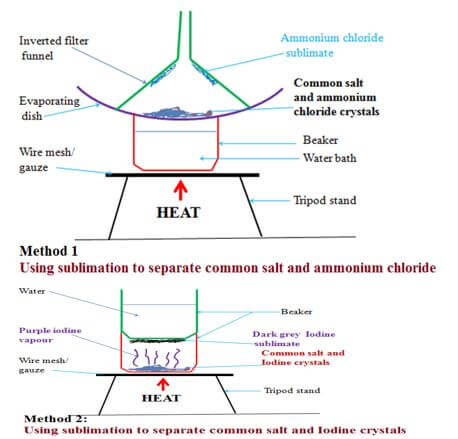
Observation
- With ammonium chloride/common salt mixture
- White fumes produced.
- White sublimate deposited
- Colourless residue left
- With Iodine/common salt mixture
- Purple fumes produced.
- Dark grey sublimate deposited
- Colourless residue left
Explanation
- On heating a mixture of ammonium chloride and common salt, a white fume of ammonium chloride is produced. The white fumes solidify as white sublimate on the cooler parts. Common salt remains as residue.
Chemical equation:
Ammonium chloride solid ⇌ Ammonium chloride gas - On heating a mixture of Iodine and common salt, a purple fume of Iodine vapour is produced. The purple fumes solidify as dark grey sublimate on the cooler parts. Common salt remains as residue.
Chemical equation:
Iodine solid ⇌ Iodine gas
Chromatography is a method of separating components of a solution mixture by passing it through a medium where the different components move at different rates. The medium through which the solution mixture is passed is called absorbent material.
Paper chromatography is a method of separating colored dyes by using paper as the absorbent material.
Since dyes are insoluble/do not dissolve in water, ethanol and propanone are used as suitable solvents for dissolving the dye.
Practically, a simple paper chromatography involve placing a dye/material on the absorbent material, adding slowly a suitable soluble solvent on the dye/material using a dropper, the solvent spread out on the absorbent material carrying the soluble dye away from the origin.
The spot on which the dye is initially/originally placed is called baseline. The farthest point the solvent spread is called solvent front.
The farthest a dye can be spread by the solvent depend on:
- Density of the dye-the denser the dye, the less it spread from the basely ne by the solvent.
- Stickiness of the dye-some dyes sticks on the absorbent material more than other thus do not spread far from baseline.
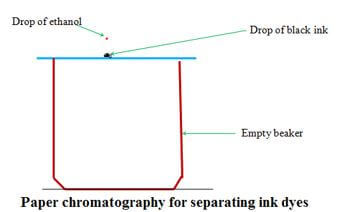
Experiment: To investigate the colors in ink
Procedure
Method 1
Place a filter paper on an empty beaker. Put a drop of black/blue ink in the centre of the filter paper. Wait for about one minute for the ink drop to spread. Using a clean teat pipette/dropper add one drop of ethanol/propanone. Wait for about one minute for the ink drop to spread further. Add about twenty other drops of ethanol waiting for about one minute before each addition. Allow the filter paper to dry.
Experiment: To investigate the colors in ink
Procedure
Method 2
Cut an 8 centimeter thin strip of a filter paper. At about 3cm on the strip, place a drop of ink. Place the filter paper in a 10cm length boiling tube containing 5cm3 of ethanol. Ensure the cut strip of the filter paper just dips into the ethanol towards the ink mark. Cover the boiling tube. Wait for about twenty minutes. Remove the boiling tube and allow the filter paper to dry.
Set up of apparatus
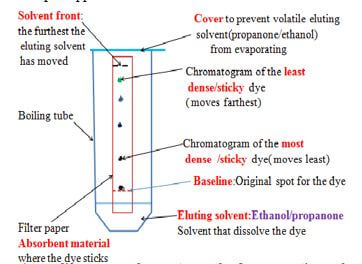
Explanation
When a drop of ink is placed on an absorbent material it sticks. On adding an eluting solvent, it dissolves the dye spread out with it. The denser and sticky pure dye move least. The least dense/sticky pure dye move farthest. A pure dye will produce the same chromatogram/spot if the same eluting solvent is used on the same absorbent material. Comparing the distance moved by a pure dye with a mixture, the coloured dyes in a mixture can be deduced as below:
Example 1
The chromatogram of pure dyes A, B ,C and a dye mixture D is shown below Determine the pure dyes present in D. On the diagram show:
- the solvent front
- Baseline
- the most soluble pure dye
Chromatogram showing pure A, B , C and mixture D.
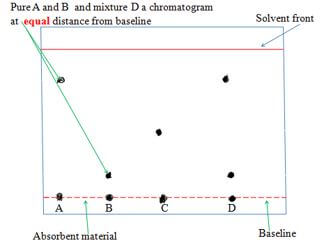
Solvent extraction
Solvent extraction is a method of separating oil from nuts/seeds. Most nuts contain oil. First the nuts are crushed to reduce their size and increase the surface area. A suitable volatile solvent is added. The mixture is filtered. The filtrate solvent is then allowed to crystallize leaving the oil/fat. If a filter paper is rubbed/smeared with the oil/fat, it becomes translucent. This is the test for the presence of oil/fat.
Experiment: To extract oil from Macadamia nut seeds
Procedure
Crush Macadamia nut seeds form the hard outer cover .Place the inner soft seed into a mortar. Crush (add a little sand to assist in crushing).
Add a little propanone and continue crushing. Continue crushing and adding a little propanone until there is more liquid mixture than the solid. Decant/filter. Put the filtrate into an evaporating dish. Vapourize the solvent using solar energy /sunlight. Smear/rub a portion of the residue left after evaporation on a clean dry filter paper.
Observation /Explanation
Propanone dissolve fat/oil in the macadamia nuts. Propanone is more volatile (lower boiling point) than oil/fat. In sunlight/solar energy, propanone evaporate/vaporize leaving oil/fat(has a higher boiling point).Any seed like corn, wheat , rice, soya bean may be used instead of macadamia seed. When oil/fat is rubbed/ smeared on an opaque paper, it becomes translucent.
Crystallization
Crystallization is the process of using solubility of a solute/solid to obtain the solute/solid crystals from a saturated solution by cooling or heating the solution.
A crystal is the smallest regular shaped particle of a solute. Every solute has unique shape of its crystals.
Some solutions form crystals when heated. This is because less solute dissolves at higher temperature. Some other solutions form crystals when cooled. This is because less solute dissolves at lower temperature.
Experiment; To crystallize copper (II) sulphate (VI) solution
Procedure:
Place about one spatula full of hydrated copper sulphate (VI) crystals into 200cm3 of distilled water in a beaker. Stir. Continue adding a little more of the hydrated copper sulphate (VI) crystals and stirring until no more dissolve. Decant/filter. Cover the filtrate with a filter paper. Pierce and make small holes on the filter paper cover. Preserve the experiment for about seven days.
Observation/Explanation
Large blue crystals formed
When hydrated copper (II) sulphate crystals are placed in water, they dissolve to form copper (II) sulphate solution. After some days water slowly evaporate leaving large crystals of copper (II) sulphate. If the mixture is heated to dryness, small crystals are formed.
Using Magnets
Mixtures containing substances that are attracted by magnets can be separated using a magnet. We can separate iron from a mixture of sand and iron, as only the iron is attracted to the magnet.
Download Mixtures, Elements and Compounds - Grade 7 Integrated Science Revision Notes.
Tap Here to Download for 30/-
Get on WhatsApp for 30/-
Why download?
- ✔ To read offline at any time.
- ✔ To Print at your convenience
- ✔ Share Easily with Friends / Students
